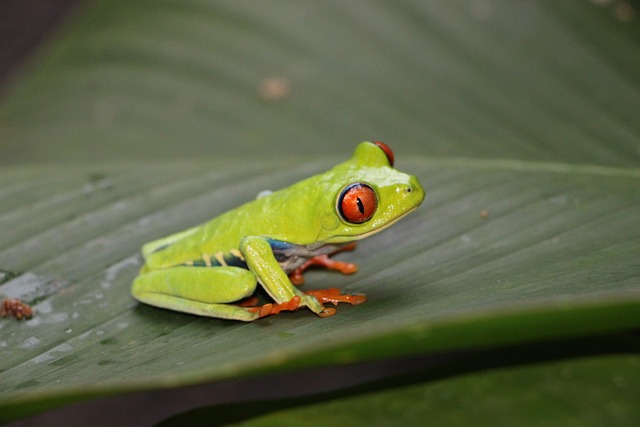Don’t forget to read all these red eyed tree frog facts for kids. True to its name, red-eyed frogs (Agalychnis callidryas) have real red eyes and tapered noses. They have green body with yellow streaks all over its body that also gives a faint shade of blue color. Frogs have webbed toes and feet. The length of the species vary with males are 2½ – 3 inches (6.35-7.62 cm) long. The juveniles are originally brown in color; however, with the maturity they turn into green color. Nevertheless, the adult species are capable to alter its color according to the surrounding environment and its mood.
The red-eyed frogs have smooth skin from the front while at the back the skin is slightly rough. These types of amphibians are also arboreal animals as they spend most of their time in trees. This is why they are also one of the best jumpers. Being non-poisonous by nature, the red-eyed frogs tend to defend themselves by camouflaging. Most of the daytime, these species are immobile and they shield their blue eyes with black eyes. Red-eyed frogs will not open their eyes during this time. This makes them to appear fully green in leaves. These frogs are facing number of threats and all coming from human encroachments such as commercial development, housing and urban regions, agricultural crops, small-holder farming, agro-industry farming, harvesting of wood, pollution, and forestry effluents.
 Red Eyed Tree Frog Facts For Kids
Red Eyed Tree Frog Facts For Kids
- These species are primarily carnivorous and are thus rely on flies, bugs, crickets, grasshoppers, moths, and other insects. They employ their sticky long tongue to catch all these. Red-eyed frogs are known to prey on other frogs. They are nocturnal as they hunt only at night.
- According to few researchers, red-eyed frogs tend to disturb their branches in order to show that mating season has arrived; find out the mate. This can also be understood in this pretext that these vertebrates make use of vibrations to communicate with each other. However, not all species do this as there are some that produces different sounds or warnings to call their mates.
- During rainfall, the male tend to call ‘chack’ to attract female.
- The females are responsible for finding the right leave to lay eggs as males are mounted on her back for a number of hours. The leaves are normally chosen on pond or other freshwater habitats. Consequently, these eggs give rise to the tadpoles.
- Some of the most common predators of tadpoles are beetles, dragonflies, and fish. These tadpoles will not come out of water for several months until and unless they become frogs or metamorphose.
- After being turned into frogs, they are sometimes welcomed by snakes, birds and bats as potential predators. The young frogs tend to feed on flies, bugs, and other tiny insects. They will reach the maturity age after 2 years and start mating at the age of 3 – 4 years. The lifespan of tree-frogs is 5 years.
- These red-eyed frogs are sometimes confused with the Chorus Frogs.
- These types of frogs are normally found in ponds and rivers especially in rainforests of southern Mexico across Central America while extending to Columbia.

- There are few scientists that hold that red-eyed frogs have advanced its glowing red peepers in order to upset its predators at least for changing their priority as their diet.
- When provoked, they display their red flash eyes and show the yellowish-orange webbed feet.
- Despite their shrinking habitats, red-eyed frogs are not considered to be endangered.
- When keeping these species as pets, bear in mind two important things; they are expensive as well as fragile so beginners are advised not to keep them in captivity.
- The shaking of branches on which they’re sitting might be an aggressive strut to notify other males to back up.
- The length of the males measure around 2 inches while males are fairly larger that is 3 inches.
- They have powerful jumping legs.
- The males tend to fertilize eggs as they are deposited.






Leave a Reply